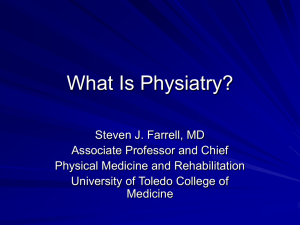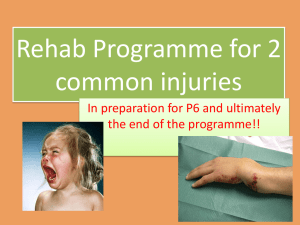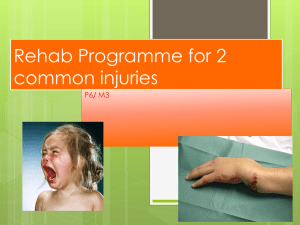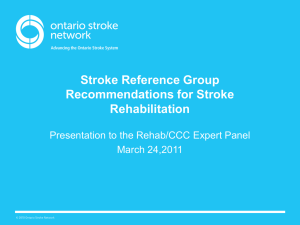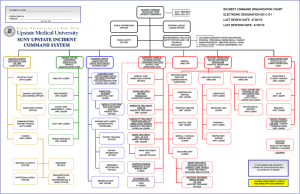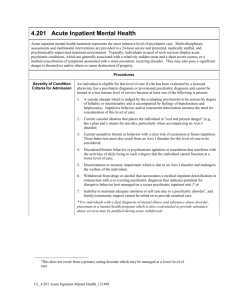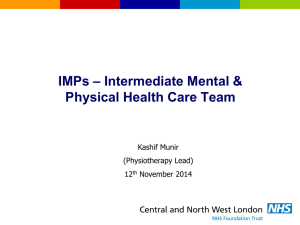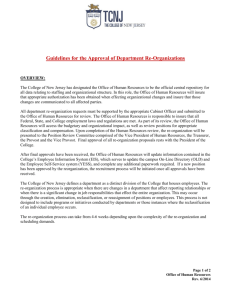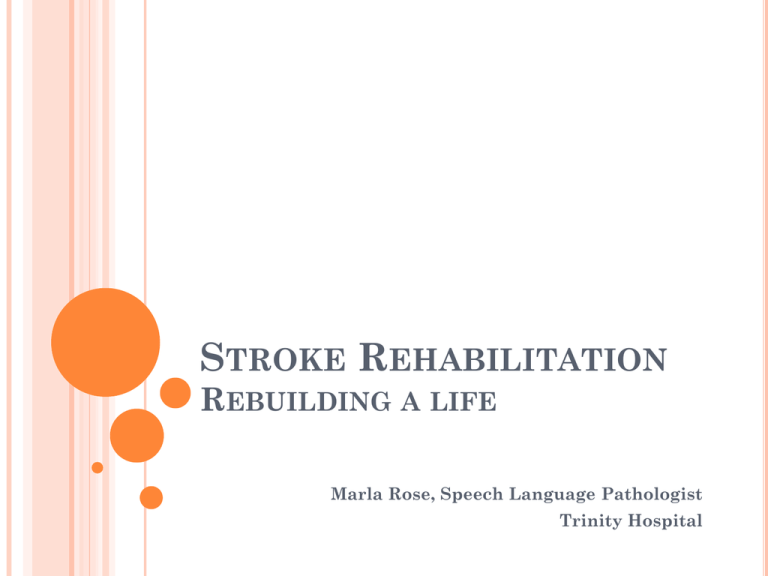
STROKE REHABILITATION
REBUILDING A LIFE
Marla Rose, Speech Language Pathologist
Trinity Hospital
OBJECTIVES
Discuss the multiple levels of rehabilitation
Therapeutic services provided from acute care to
home.
Therapeutic rationale for intervention and for
discharge planning
WHO ARE WE TALKING ABOUT
In UNITED STATES, approximately 795,000
people suffer a stroke each year.
Approximately three-quarters of all strokes occur
in people over the age of 65.
Approximately one fourth of strokes occur in
people under the age of 65.
TRINITY HOSPITAL - 2011
165 admitted with stroke as primary diagnosis
83% Ischemic
11% Intracerebral hemorrahage
5% Subarachnoid hemorrhage
Average age: 70.5 years
Discharge disposition
42% Home
23% Inpatient rehab
13% SNF
7% Expired
REBUILDING A LIFE
Stroke is the leading
cause of serious, longterm disability in the
United States.
ROAD TO RECOVERY
RECOVERY STATISTICS
Much variability in statistics
Most improvement noted in the first 6 months
5% show continued improvement up to 12
months
47 – 76% achieve partial or total independence in
ADLs
MULTIPLE LEVELS OF REHABILITATION
Home – Independent
Home + Outpatient tx
Home + Home Care
Skilled Nursing Facility
Inpatient Rehab
Acute Care
FACTORS PREDICTING ADL OUTCOMES
Advanced age
Comorbidities
Myocardial infarction
Diabetes mellitus
Severe stroke
Severe weakness
Poor sitting balance
Visuo-spatial deficits
Mental changes
Incontinence
Low initial ADL
scores
Delay in initiating
rehabilitation
following onset
REHABILITATION TEAM
Patient and family
Physicians
Physical Therapist
Occupational
Therapist
Speech-language
Pathologist
Nurses
Dietician
Social Worker
Orthotist
Mental Health
Insurance Company
Community Resources
ACUTE CARE
ACUTE LOS: 4.6 DAYS
PT/OT:
Diagnostic intervention
Range of motion
Introduce activity/exercise
Assess potential for more aggressive intervention
Provide patient/caregiver education
Assist with discharge planning
ACUTE CARE
ACUTE LOS: 4.6 DAYS
SLP
Diagnostic intervention
Assess cognitive - communication skills
Assess for potential to participate in more aggressive
intervention
Provide patient/family education
Assist with discharge planning
ACUTE CARE
SLP
Assess swallowing and make recommendations
Monitor swallowing function
Assess for potential to participate in structured
intervention
Provide patient/family education
Assist with discharge planning
ACUTE DISCHARGE PLANNING
Home with outpatient therapy
Home with Home Health Therapy
Inpatient rehab
Skilled nursing facility
TEAM members: patient and family; physicians;
inpatient rehab medical director; case managers; social
workers; therapists; 3rd party payer.
REHABILITATION THEORY
Evidence from clinical trial supports early
initiation of therapy.
Early improvement (3 – 6 months):
Resolution of local edema
Resorption of local toxins
Improvement of local circulation
Recovery of partially damaged neurons
REHABILITATION THEORY
Ongoing improvement (for many months)
Neuroplasticity – the ability of the brain to modify
its structural and functional organization
New synaptic connections
Activating latent functional pathways
Utilization of redundant neural pathways
REHABILITATION THEORY
To influence brain re-organization we must DO
SOMETHING to facilitate the lost skill. Therapy
exercise must promote USE rather than non-use.
Repetitive, skilled, functional movement is
beneficial in facilitation of brain re-organization.
MEDICARE’S EXPECTATION
Therapeutic services provided require the skilled
services of a qualified therapist.
The patient’s condition will improve significantly
in a reasonable and generally predictable length
of time.
Therapy results in recovery or improvement in
function.
INPATIENT REHAB
Trinity Hospital – St. Joseph’s Campus
INPATIENT REHAB
WHAT YOU NEED TO KNOW
3 hour rule
Must benefit from at least 2 therapy disciplines
Length of stay
Determined by Medicare
Admit severity
Co-morbidities
Goal is to discharge patients home
ADMIT SEVERITY:
HOW IS THIS DETERMINED?
Functional Independence Measure: FIM
National rating scale, 1 – 7
7 = Independent
1 = Total Assistance
Reflects the burden of care; how much
assistance is required for the patient to carry out
ADLs.
FIM
Eating
Grooming
Bathing
Upper body dressing
Lower body dressing
Toileting
Bladder Management
Bowel Management
Bed to chair transfer
Toilet Transfer
Tub/shower transfer
Locomotion
Stairs
Comprehension
Expression
Social Interaction
Problem solving
Memory
INPATIENT REHAB
HOW IS IT DIFFERENT
Therapy intensity
Mandatory participation
Therapy staff
Social Worker
Medical director – visits patients daily
Nursing staff and the scope of their
responsibilities
MEDICAL COMPLICATIONS
Pulmonary aspiration, pneumonia – 40%
Urinary tract infection – 40%
Depression – 30%
Musculoskeletal pain – 30%
Falls – 25%
Malnutrition – 16%
Venous thromboembolism 6%
Pressure ulcer – 3%
NURSING STAFF
They’re not ONLY nurses
They’re NURSE THERAPISTS
INPATIENT REHAB NURSING STAFF
Daily, frequent contact with patients
Reinforce therapy strategies
Provide frequent opportunities to practice what
patients are learning in therapy
They MUST know patients’ level of functioning in
16 FIM areas
Current level
Where they are progressing
Where they are not progressing
How their level of functioning influences the
discharge plans.
INPATIENT REHAB OUTCOMES
# of stroke patients
Average Age
ALOS (days)
D/C Home
D/C SNF
Ave FIM gain points
(target: 28 points)
2011
51
72
13
80%
16%
28
2007
72
73
14
74%
17%
22
PHYSICAL THERAPY
Exercises to address the sensory-motor
physiology
Apply the physiological gains to functional ADLs
OCCUPATIONAL THERAPY
Exercises to address the sensory-motor
physiology
Apply the physiological gains to functional ADLs
SPEECH-LANGUAGE PATHOLOGY
Exercises to address the sensory-motor
physiology of swallowing
Apply the physiological gains to functional
swallow
SPEECH-LANGUAGE PATHOLOGY
Exercises to address neurological processing
and/or physiology for communication skills
Apply gains to functional communication
interactions
SKILLED NURSING FACILITY
Scenario #1
Patient transferred from acute care immediately
following stroke.
Scenario #2
Patient transferred from inpatient rehab with
Good progress made and positive prognosis
Poor progress made and guarded prognosis
SKILLED NURSING FACILITY
Philosophy of brain re-organization - same
Rate of progress will likely be slower
Intensity of therapy will likely be less
Possibly less daily activity
Nursing staff ‘hands-on’ will likely be less
Primary physician will not see patient daily
Eventually may begin to include exercises
designed to develop compensatory skills
HOME WITH HOME CARE
Scenario # 1
Patient discharged from inpatient rehab with
recommendations to continue therapy.
Scenario #2
Patient discharged from acute care with
recommendations for therapy.
HOME WITH HOME CARE
Philosophy of brain re-organization - same
Rate of progress may possibly be slower
Intensity of therapy will likely be less
Possibly less daily activity
Advantage of addressing ADLs in their home
Motivation
Nurse is available on limited basis
Eventually design therapy goals and exercises to
address work and social needs
Eventually begin to include exercises designed to
develop compensatory skills
HOME BOUND
HOME WITH OUTPATIENT THERAPY
Scenario # 1
Scenario #2
Discharged home from inpatient rehab with
recommendations for outpatient therapy.
Scenario #3
Discharged home from acute with recommendations
for outpatient therapy.
Discharged home from SNF with recommendations
for outpatient therapy.
Scenario #4
Discharged from Home Care services with
recommendations for outpatient therapy.
HOME WITH OUTPATIENT THERAPY
Philosophy of brain re-organization - same
Rate of progress will eventually be slower
Intensity of therapy will likely be less
Possibly less daily activity
Motivation
Eventually design therapy goals and exercises to
address work and social needs in addition to
ADLs
Eventually begin to include exercises designed to
develop compensatory skills
THROUGH ALL LEVELS OF REHABILITATION
Patient goals
Medicare/3rd party payer expectations
Neuroplasticity theory
Target actual functional use BEFORE
compensatory training



